Teenager Dies in Tractor Overturn When Home-Made Rollbar Fails

Case No.: 03IA020 Report Date: October 10, 2003
SUMMARY
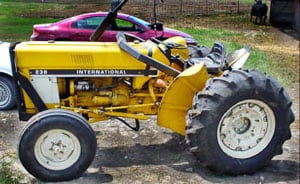 |
|
Photo 1 – Side view of tractor showing rollbar collapsed forward.
|
During the summer of 2003, a 14- year-old boy died while helping his grandfather clear farmland of fence posts. The boy was operating a utility tractor equipped with a homemade roll bar and seatbelt. They had successfully removed several posts using the tractor’s three-point hitch lift arms, but encountered a post that wouldn’t budge. The grandfather switched to another method to pull posts using the rear wheel, something he had learned from his father many years ago. They backed up the tractor into position, adjacent to the 6-inch (15 cm) diameter wooden fence post. The tractor was facing up a slight slope. An old chain with ¼ inch (6 mm) links was secured to the bottom of the post and the other end was looped around the rear tire. Normally, as the wheel would turn, it would pull the post upward and forward. The boy had the tractor in first gear, with throttle applied. As he released the clutch, the post, buried 4 feet (1.2 m) deep in dry ground, did not move, but the tractor’s front end jumped upward. The grandfather yelled, but the boy had no time to react, and the tractor rolled completely over backwards. The self-made rollbar was sturdy and did not break or bend, but large pieces of the axle housing snapped off from both sides as the rollbar collapsed. The boy was instantly crushed underneath. The tractor had been previously used for city maintenance, and originally had a two-post factory-installed Roll-Over Protective Structure (ROPS). The tractor was sold through an auction and was bought by the family without this ROPS. The original mounting brackets were still in place, but the long bolts connecting the top and bottom brackets were missing. The new rollbar was welded to the existing top bracket, which was bolted only to the top mounting base of the cast iron axle housing. Without the long bolts between the top and bottom brackets, this installation did not provide adequate strength for the rollbar attachment to the axle, and the axle housings broke, making the rollbar ineffective.
RECOMMENDATIONS based on our investigation are as follows:
- Factory installed Roll-Over Protective Structures (ROPS) should not be removed from tractors.
- Non-ROPS tractors should be retrofitted with approved ROPS; otherwise, they should be recycled, or retired to stationary power source use.
- Self-made rollbars are not recommended, as they may not provide adequate structural strength in an overturn.
- The rear wheel of a tractor should not be used to pull posts from the ground.
- Youth under 16 years of age should not operate tractors, unless they have received tractor operator training.
INTRODUCTION
During the summer of 2003, a 14-year-old boy was killed while helping his grandfather pull fence posts with a tractor. The Iowa FACE program was notified the next day by the county sheriff and began an investigation. Contact was made with the family through the Sheriff’s office, and a site visit was conducted one month after the incident. Two FACE investigators traveled to see the tractor and talk with the grandfather, who was an eyewitness of the incident. Photographs were taken of the tractor as well as the terrain where the overturn occurred. Information was obtained from the dealer who sold the tractor to the family, and the original owner. Several experts were consulted regarding technical issues related to ROPS.
The incident occurred on a property, which had recently been purchased by the victim’s uncle. The property was 150 acres in size; 100 acres of it were timberland, and 50 acres were old pasture, now planted in soybeans. At the time of the incident, the owner’s father was using the tractor to clean up the property and remove old electric fence lines. He received help from his 14-year-old grandson (the owner’s nephew), who lived with his parents in the area.
There were no safety programs or written policies in place at this farm, but many efforts were made to ensure safety. This tractor model was purchased specifically because it had a fairly low center of gravity, and it was less likely to overturn in the hilly terrain. A self-made rollbar* and seatbelt were added on the tractor. The seatbelt was being used at the time of the incident. The tractor also had a Slow Moving Vehicle (SMV) sign, rear wheel weights, and a heavy gauge steel protective grill for the front. Overall, the tractor appeared to be in good repair. The grandson had received instruction and warnings about tractor safety, and the grandfather never left him alone while working. The victim had experience with machinery, and had operated other tractors at his home.
* Note: The term rollbar is used in this report to describe the self-made (home-made) structure instead of Roll-Over Protective Structure (ROPS), which is used to describe a structure that meets ASAE S383.1 requirements.1
INVESTIGATION
The injury occurred on a parcel of ground that was being cleared for primarily recreational use. The higher parts in the middle of the property had been open pasture land, and the surrounding hillsides were heavily wooded. This scenic property had been previously owned by the family for several generations, and was recently acquired by the victim’s uncle. Family members contributed to clearing the land, and the grandfather was busy removing old machinery and junk. There was an electric fence line for livestock around the pasture that needed to go. The grandson was eager to help, knowing he would be allowed to operate the small utility tractor, which had been purchased a few months earlier. The family was very concerned about safety, and the grandfather would never let the boy operate the tractor alone, nor let him use it on rough or dangerous ground. The victim had been helping his grandfather a couple times each week, a few hours each time.
The tractor was bought used from an out-of-state dealer who had in turn purchased it at a public auction. The tractor was previously used by a city maintenance crew for mowing and general maintenance duties. It was a 1979 International Harvester model 238, manufactured in Great Britain, and was originally equipped with a 2-post factory-mounted ROPS. When purchased by the family, the tractor did not have the original ROPS intact. The ROPS frame had been cut off above the attachment points for the fenders, and all long bolts had been removed. The bottom brackets had other bolt holes and mounting elements, some of which showed wear from previous use. (see Photos 2 & 3).
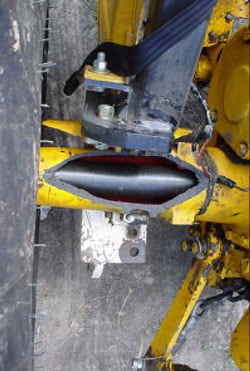 |
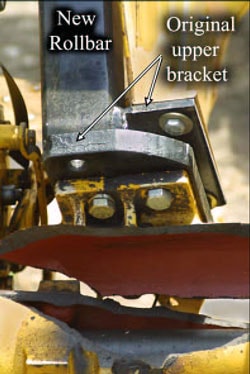 |
| Photo 2 – Close-up view of left rear axle, looking down from the top. | Photo 3 – Close-up view of right axle showing construction of rollbar and its attachment to the axle housing with short bolts. This also shows the original ROPS upper bracket with fender attachment, repainted to look new (refer to Diagram). |
Both the top and bottom mounting brackets for the original ROPS were intact and in place (please see Diagram), however, the four 9-inch long (23 cm) bolts between the top and bottom brackets were missing. These bolts were an integral part of the ROPS design specifications and provided significant strength as they distributed mechanical stress to the entire axle housing in the event of an overturn. The bottom bracket was bolted only to the bottom mounting base of the axle, and the top bracket, with fender and new rollbar, was attached with short bolts to the top mounting base of the axle housing. The original bolt configuration is shown in the specification sheet (see Diagram).
This tractor model is not common in the U.S., but a similar model with a different model number has been on the market for agricultural use. According to the ROPS guide, last updated in 1997, there were no ROPS commercially available for neither model2. The victim’s father worked at a local manufacturing plant as a certified welder. He designed and built a custom rollbar for this tractor, made of ¼ inch (6.3 mm) thick, 3-inch (76 mm) square steel tubing, welded to the existing top mounting bracket. The mounting brackets had approximately 2×2 inch (50×50 mm) and 2 inch (50 mm) high stubs of steel remaining from the original ROPS. The new rollbar was made to slip over these stubs from the original ROPS, welded to the mounting brackets, then painted with black paint (see Photos 2 & 3).
By visual observation, the rollbar was built very well with precise cuts, consistent welding, and detailed finish. The seatbelt was bolted onto the sides of the rollbar. The short bolts connecting the brackets to the mounting bases were different grades (SAE Grade 5 and 8). The missing long bolts connecting the top and bottom brackets were not replaced. The bottom mounting brackets had bolt holes and wear marks which could give an impression that the brackets were used for some purpose other than being part of the ROPS mounting system.
The victim and his grandfather were removing an electric fence line surrounding the old pasture (see Photo 5). The fence was made of 6-inch (15 cm) diameter creosote wooden posts (see Photo 4) and small fiberglass posts between the wood posts. The posts appeared relatively new, and were in good condition. They were eight feet (2.4 m) long and set approximately 4 feet (1.2 m) deep in the ground. The fiberglass posts were easily removed by hand, but the wood posts required significant force. Initially, the grandfather attempted to pull this post using the 3-point hitch lift arms of the tractor. This was unsuccessful, for the hydraulics did not have enough power. Their alternate method was to use the rear wheel and a chain, which had worked successfully prior to this incident. They backed the tractor in position with the right rear wheel adjacent to the post. A chain was attached to the base of the post, and the other end looped through the rim and around the rear tire. On other occasions, when the rear wheel turned, it would yank the post up and forward out of the ground, making it a quick and easy method to remove posts, something the grandfather had learned from his father long ago.
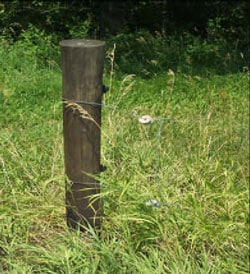 |
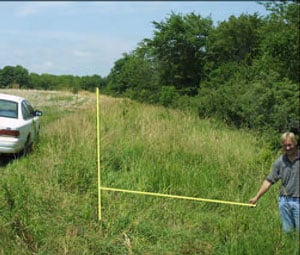 |
| Photo 4 –Wooden fence post, similar to the one in the incident. | Photo 5 – Site of the overturn showing the location of the post and the downward ground slope of 8 degrees. |
The victim was driving the tractor and his grandfather was assisting with the chain. The boy was using both the hand- and foot-operated throttles, but it is unknown where the hand throttle was set, and how much foot throttle was applied at the time. When the boy released the clutch to move the tractor forward, the post did not budge, but the tractor’s front end immediately jumped upward. The grandfather yelled for him to push in the clutch pedal, but there was no time to react or stop the overturn. The front end continued to rise and the tractor rolled over backwards, slamming to the ground and instantly killing the boy. The rollbar collapsed and failed to provide protection. It did not bend or break, but the cast iron axle housings on both sides broke, leaving large pieces of the housing still bolted to the rollbar brackets. (see Photos 2 , 3, 6).
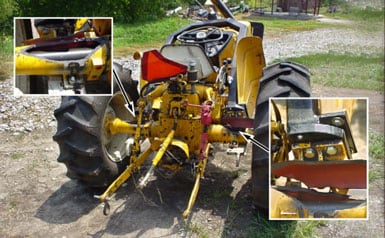 |
|
Photo 6 – Rear view of tractor with inserted photo enlargement of left and right broken axle housings.
|
By visual inspection, the 3/8 (9.5 mm) cast iron housing material did not have obvious pre-existing damage. The cast iron material appeared consistent in all areas on both sides where pieces were torn from the top of the housings.
The ground was sloping (about 8 degrees) near the post, and the tractor was facing uphill. This may have contributed to the overturn and the rollbar failure. It took a few degrees less rotation and time for the tractor to reach the point of no return, leaving less time to react and stop the overturn. Secondly, the downhill behind the tractor allowed more rotation and momentum before the rollbar crashed into the ground, increasing the forces on the rollbar. After the incident, the post had loosened so that it could be removed by hand by those who arrived at the scene. The boy was dead at the scene when emergency crews arrived.
CAUSE OF DEATH
The cause of death taken from the Iowa Medical Examiner’s report was, “asphyxiation due to chest constriction.” No autopsy was performed.
RECOMMENDATIONS / DISCUSSION
Recommendation 1: Factory installed Roll-Over Protective Structures (ROPS) should not be removed from tractors.
Discussion: About half of the 4.7 million tractors in the U.S. do not have ROPS3. Since 1985, manufacturers have provided ROPS on all new tractors sold in the US, and in some countries, ROPS have been required since 1960’s. The tractor in this case originally had a factory installed ROPS. Some owners have removed ROPS to facilitate operation in low clearance buildings or orchards, or for other reasons. It is not known why the ROPS and mounting bolts had been removed from this tractor. Reportedly, the tractor was previously used by city employees and it had the 2-post factory-installed ROPS in place. It is likely that the original ROPS, if properly installed, would have provided protection in this case. Using an approved ROPS and seat belt provides a protective envelope around the operator, and in many cases, prevents the tractor from overturning completely.
Recommendation 2: Non-ROPS tractors should be retrofitted with approved ROPS; otherwise, they should be recycled, or retired to stationary power source use.
Discussion: Many tractor manufacturers offer approved ROPS at cost for older tractors. Some aftermarket manufacturers also have approved ROPS available for various makes and models. Whenever possible, tractors should be retrofitted with approved ROPS. Several tractor models, as in this case, do not have ROPS readily available on the market. Non-ROPS tractors continue to cause fatalities when used for loading, mowing, travel on roads and sloping grounds, pulling heavy objects, and removing fence posts, as in this case. For these tractors, the only safe options may include recycling the tractor, or making it a stationary power source.
Recommendation 3: Self-made roll bars are not recommended as they may not provide adequate structural strength in an overturn.
Discussion: ROPS appear simple and relatively easy to make, but they must have appropriate structural strength to absorb the energy and provide protection in the specified envelope in case of an overturn. Manufacturers design and test ROPS according to the ASAE 383.1 standard1, but it is not feasible for individuals to do so. The rollbar on this tractor appeared to be built very well by a qualified welder. The rollbar itself did not suffer significant damage in the overturn. However, the mounting of the roll bar was insufficient and the forces from the overturn broke the axle housings. It is not known if this self-made rollbar would have stayed intact if mounted according to the manufacturer’s specifications (see Diagram). Self-made roll bars are often thought to be better than nothing for overturn protection. However, without testing, the adequacy of a self-made rollbar is questionable. Given the complexities in design and testing, it is recommended that ROPS be built only by manufacturers who can ensure that the ASAE standard requirements are met.
Recommendation 4: The rear wheel of a tractor should not be used to pull posts from the ground.
Discussion: Tractors have sufficient power and torque to cause an overturn under a variety of conditions. Many rear overturns occur when pulling heavy objects, where the chain is attached higher than the centerline of the rear axle, such as the three-point hitch upper linkage. When the rear wheel is attached to a strong deeply-embedded fence post, there is a great risk that the tractor will overturn, or that the chain will break. This method has been used, especially in the past, when three point hitches and front-end loaders were not common on tractors. In this case, the chain was attached to the back side of the wheel, and the tractor was driven forward to lift the post. A safer alternative would be to attach the chain to the front side of the wheel, and back up. In that case, the torque from the wheel will push the front down rather than up. However, even this method is not recommended, as there are great risks for breaking equipment and causing injuries. Safer methods include using the three-point hitch, special jacks designed to pull fence posts, or a front end loader and large enough tractor for pulling posts from the ground.
Recommendation 5: Youth under 16 years of age should not operate tractors, unless they have received tractor operator training.
Discussion: The US Department of Labor has listed several hazardous occupations within agriculture. 29 CFR 570.570.1 (a)4 states: “The following occupations in agriculture are particularly hazardous for the employment of children below the age of 16: (1) Operating a tractor of over 20 PTO horsepower, or connecting or disconnecting an implement or any of its parts to or from such a tractor.” Several other occupations or tasks are also listed in this regulation. As this incident occurred on a family farm, the regulation may not be enforced, but the listed hazardous occupations or tasks are equally hazardous for unpaid family labor as for hired labor, and should be voluntarily complied with on family farms as well. The task of pulling fence posts with the rear wheel of the tractor on sloping ground contributed to the hazardous nature of the tractor operation in this case. A tractor training course is offered by the extension service for 14-16 year old workers, which allows them to operate tractors when employed. This course would be appropriate for youth working on their own family farm as well.
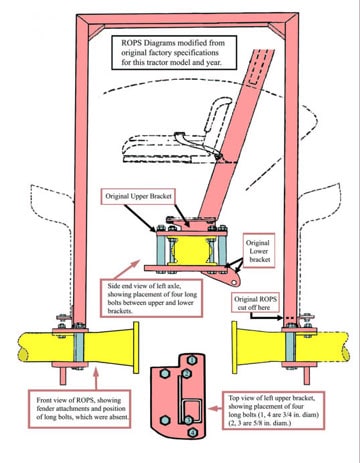
|
|
ROPS Diagrams modified from original factory specifications for this tractor model and year.
|
REFERENCES
- ASAE. Roll-Over Protective Structures (ROPS) for wheeled agricultural tractors. ASAE standard S383.1.
- National Farm Medicine Center. 1997. A guide to Agricultural Tractor Rollover Protective Structures. Available at: http://www3.marshfieldclinic.org/NFMC//?page=nfmc_rops_guideexternal icon (Accessed 10/13/03). (Link updated 4/4/2013)
- Myers J. 2003. Tractor operational safety and health update. Presentation at NIOSH tractor meeting in Pittsburgh, February 13, 2003.
- 29 CFR 570.570.1 Hazardous occupations involved in agriculture. Available at: http://www.ecfr.gov/cgi-bin/text-idx?c=ecfr&SID=860abb8c3986a6c5452d911662628ae5&rgn=div8&view=text&node=29:3.1.1.1.31.6.132.2&idno=29 external icon(Accessed 10/13/03). (Link updated 3/20/2013)
Fatality Assessment and Control Evaluation
FACE
FACE is an occupational fatality investigation and surveillance program of the National Institute for Occupational Safety and Health (NIOSH). In the state of Iowa, The University of Iowa, in conjunction with the Iowa Department of Public Health carries out the FACE program. The NIOSH head office in Morgantown, West Virginia, carries out an intramural FACE program and funds statebased programs in Alaska, California, Iowa, Kentucky, Massachusetts, Michigan, Minnesota, Nebraska, New Jersey, New York, Oklahoma, Oregon, Washington, West Virginia, and Wisconsin.
The purpose of FACE is to identify all occupational fatalities in the participating states, conduct in depth investigations on specific types of fatalities, and make recommendations regarding prevention. NIOSH collects this information nationally and publishes reports and Alerts, which are disseminated widely to the involved industries. NIOSH FACE publications are available from the NIOSH Distribution Center (1-800-35NIOSH).
Iowa FACE publishes case reports, one page Warnings, and articles in trade journals. Most of this information is posted on our web site listed below. Copies of the reports and Warnings are available by contacting our offices in Iowa City, IA.
The Iowa FACE team consists of the following from the University of Iowa: Craig Zwerling, MD, PhD, MPH, Principal Investigator; Wayne Johnson, MD, Chief Investigator; John Lundell, MA, Coordinator; Risto Rautiainen, PhD, Co-Investigator, Martin L. Jones, PhD, CIH, CSP, Co- Investigator, and John Kraemer, PA. From the Office of The State Medical Examiner.
To contact Iowa State FACE program personnel regarding State-based FACE reports, please use information listed on the Contact Sheet on the NIOSH FACE web site Please contact In-house FACE program personnel regarding In-house FACE reports and to gain assistance when State-FACE program personnel cannot be reached.
